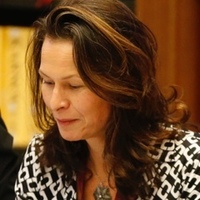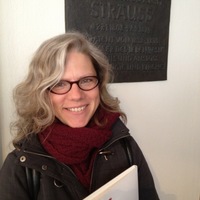
Diana Davis
My research interests focus on the market for French decorative art in early nineteenth-century Britain and the role of the dealer. My doctoral thesis (University of Buckingham, 2016) was on 'British Dealers and the Making of the Anglo-Gallic Interior, 1785-1853' and it forms the basis for my book, 'The Tastemakers' published by the Getty Research Institute in 2020.
less
Related Authors
Jacques Schuhmacher
Victoria and Albert Museum
Joy CADOR
Université Paris 1 - Panthéon-Sorbonne
German Historical Institute London Bulletin
German Historical Institute London
Pedram Khosronejad
Western Sydney University
Pamela Klassen
University of Toronto







Uploads
Papers by Diana Davis
Diana Davis
Paper given to ‘The V&A and its Jewish Heritage: Objects and Stories’, conference held on 26 November 2024
In 1872 Henry Cole, founder of the V&A, took the waters at Bad Homburg near Frankfurt. Ailing and nearing retirement, he remained indefatigable in his quest for museum objects. On 21 August he wrote, ‘Goldsmiths Antiquities Shop. Made purchases & he agreed to send other things on approval.’ These included a rare, 17th-century silver gilt cup and three portfolios of medieval and early Renaissance manuscript cuttings. The relationship lasted until the 1960s, ending with the death of Julius Goldschmidt in 1964. For this leading German-Jewish dealership, decades of entrepreneurial success in the 19th and early 20th century ended in liquidation and displacement under National Socialism, followed by post-war reinvention in London. The objects Goldschmidts sold to the V&A and to its donors highlight key moments in that story.
No archive survives. However, sale catalogues, a memorial tribute to Selig, collection and museum records show how this multi-generational Jewish dealership, comparable in the quality of its inventory and stellar client list to Duveen’s, Bernheimer’s and Durlacher’s, deployed not only expertise, but family, and religious networks across borders to achieve market dominance.
George Byng (1764-1847) inherited Wrotham Park in 1789, the year of the French Revolution. The association is significant because the Revolution transformed the London art market and with it elite collecting practice. Byng bought furniture, porcelain, bronzework, silver, Kunstkammer, and Old Master paintings but his Francophile preferences shine through. Wrotham's interior was emblematic of an innovative Anglo-Gallic decorative style in which the old art of the ancien regime became as fashionable as the new and furnishings made by British dealers were highly prized. This lecture examines how dealers enabled this paradigm shift in taste: investing ancien régime art with royal romance and age value; displaying old and new together in elegant shops; altering original objects to conform to current taste and unifying the whole through the nomenclature 'Louis XIV style'. However, Wrotham was never French, nor intended to be so. In this Palladian house, Byng displayed his French decorative art with Regency furniture and dealer-made furnishings inspired by eighteenth-century France but modified to suit British preference. Moreover, his art choices melded French and antiquarian taste. The seminal influence of the dealer Edward Holmes Baldock is examined in an analysis of his porcelain-mounted and marquetry furniture and modified porcelain. Byng was a man of discerning taste but his collecting was shaped by unique circumstances and directed by the dealer who, acting as retailer, maker and decorator, created a new Anglo-Gallic decorative style.
Diana Davis
Paper given to ‘The V&A and its Jewish Heritage: Objects and Stories’, conference held on 26 November 2024
In 1872 Henry Cole, founder of the V&A, took the waters at Bad Homburg near Frankfurt. Ailing and nearing retirement, he remained indefatigable in his quest for museum objects. On 21 August he wrote, ‘Goldsmiths Antiquities Shop. Made purchases & he agreed to send other things on approval.’ These included a rare, 17th-century silver gilt cup and three portfolios of medieval and early Renaissance manuscript cuttings. The relationship lasted until the 1960s, ending with the death of Julius Goldschmidt in 1964. For this leading German-Jewish dealership, decades of entrepreneurial success in the 19th and early 20th century ended in liquidation and displacement under National Socialism, followed by post-war reinvention in London. The objects Goldschmidts sold to the V&A and to its donors highlight key moments in that story.
No archive survives. However, sale catalogues, a memorial tribute to Selig, collection and museum records show how this multi-generational Jewish dealership, comparable in the quality of its inventory and stellar client list to Duveen’s, Bernheimer’s and Durlacher’s, deployed not only expertise, but family, and religious networks across borders to achieve market dominance.
George Byng (1764-1847) inherited Wrotham Park in 1789, the year of the French Revolution. The association is significant because the Revolution transformed the London art market and with it elite collecting practice. Byng bought furniture, porcelain, bronzework, silver, Kunstkammer, and Old Master paintings but his Francophile preferences shine through. Wrotham's interior was emblematic of an innovative Anglo-Gallic decorative style in which the old art of the ancien regime became as fashionable as the new and furnishings made by British dealers were highly prized. This lecture examines how dealers enabled this paradigm shift in taste: investing ancien régime art with royal romance and age value; displaying old and new together in elegant shops; altering original objects to conform to current taste and unifying the whole through the nomenclature 'Louis XIV style'. However, Wrotham was never French, nor intended to be so. In this Palladian house, Byng displayed his French decorative art with Regency furniture and dealer-made furnishings inspired by eighteenth-century France but modified to suit British preference. Moreover, his art choices melded French and antiquarian taste. The seminal influence of the dealer Edward Holmes Baldock is examined in an analysis of his porcelain-mounted and marquetry furniture and modified porcelain. Byng was a man of discerning taste but his collecting was shaped by unique circumstances and directed by the dealer who, acting as retailer, maker and decorator, created a new Anglo-Gallic decorative style.
Edited by Diana Davis, Oliver Fairclough, and John Whitehead
Contents
Introduction. Sculpture and Ceramics: points of affinity and difference CLAIRE JONES
Sculpture en céramique, et bien plus: ornement et figuration dans les chapelles de Luca della Robbia à Impruneta
FEDERICA CARTA
Of Wit and Gallantry., On the figures of Johann Joachim Kändler in the Context of the Eighteenth-Century Fête Galante
SARAH-KATHARINE ANDRES-ACEVEDO
Mimetic Strategies in Meissen Porcelain Sacred Sculpture
SABRINA LEPS
The Early Sculptural Porcelain of François Barbin at Villeroy and Paris
ERROL MANNERS
Porcelain and Sculptural Aesthetics: The Evidence of the Zwettl Table Centrepiece
MATTHEW MARTIN
Paint it Black: A Wedgwood Bust of Antinous as Bacchus
IRIS MOON
Sculpting the Pittoresque: Clodion’s Erigone
ELIZABETH SAARI BROWNE
Porcelain and Sculpture Networks in Eighteenth-Century Paris
ALICIA CATICHA
Contributions to the Study of Porcelain and Terracotta Sculptures attributed to Giuseppe Gricci and other Sculptors active in the Buen Retiro Factory
MARÍA ÁNGELES GRANADOS ORTEGA
Les Créations Originales des Sculpteurs à la Manufacture de Sèvres (1848-90)
TAMARA PRÉAUD
Tanagra Mania: Collecting, Displaying and Emulating Greek Tanagra Figures in the Fin de Siècle
ANNE ANDERSON
An Art Director’s Approach: Gio Ponti and Ceramic Sculpture for the Richard-Ginori Factory
OLIVA RUCELLAI
In 1853 the Observer newspaper described the opulent Waterloo Gallery at the Duke of Wellington’s Apsley House, created by the architect Benjamin Dean Wyatt from 1828, as: “a rather whimsical admixture of the classical, renaissance, Louis Quatorze, and what the French call Rococo, styles.” Inspired by the Galerie des Glaces at Versailles, the room was a very British and essentially picturesque evocation of the historic French interior. Contemporaries described this decorative style as “Louis XIV” but its mix of French and British furnishings, old and new and of all dates and styles, often displayed in Palladian room settings, is best described as Anglo-Gallic. With its vibrant colours in textiles and drapery and extensive gilding, nothing could have been more different to the refined cohesion and pastel colourways of the Adam interiors which preceded it. However, the neo-classical was integral to the Anglo-Gallic interior, as in the architectural renovations of Henry Holland at Carlton House, presented to the Prince of Wales in 1783, in the new Empire furnishings bought in Paris by Thomas Bruce, 7th Earl of Elgin for his Greek Revival house, Broomhall, and in the goût grec furniture made by Nicholas Morel for Orlando Bridgeman at Weston Park. This talk will explore the origins of this new taste, founded in the dispersal of art objects and architectural elements after the French Revolution, the instrumental role of the dealers, architects and makers who fashioned these elite interiors and the patrons they supplied.